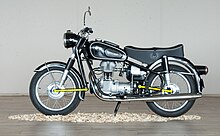Swing arm (vehicle technology)
In chassis technology, a swing arm is a type of wheel suspension .
The swing arm rotates up and down on the car body around a swivel joint with the axis transverse to the direction of travel. The wheel carrier is connected rigidly or steerable at its free end. The spring and shock absorber act on the swing arm . A distinction is made between drawn arms and pushed arms. Seen in the direction of travel, the pivot point (bearing) is in front of the wheel axle when the swing arm is pulled and behind it when the swing arm is pushed.
The swing arm is used in both front and rear suspensions. For motorcycles , it is the most common type of rear suspension.
Swing in the automobile

There have been swing arms in automobiles - all single-sided swing arms - since the 1930s, for example in the Stoewer Greif V8 , Adler Trumpf Junior (as pushed swing arms on the rear axle ). As front independent suspension , there was the "Dubonnet spring knee" . This is a pushed rocker that can be swiveled horizontally for steering. The spring and the shock absorber sit in a common housing and are operated via an angle lever (hence "knee"). All Opel except P4 and Kapitän and Admiral , that is Opel 1.3 liter and Opel 6 , Olympia , Kadett (except the "normal sedan") were equipped with this design, it ran there under the advertising name " Synchron-Federung ". But Fiat also used Dubonnet suspension in some models before World War II. The heavy spring housing with swing arm bearings, spring and shock absorber of the Dubonnet suspension contributes with its high moment of inertia to the strong tendency of this construction to flutter .
After the Second World War, swing arms were used in front-wheel drive small and medium-sized cars, mostly only in the rear and predominantly in France (from all major manufacturers) and Great Britain (BMC). The Citroën 2CV had swing arms all around (pushed in front), as did the Isetta and the following BMW 600 , 700 with swing arms at the rear ( semi-trailing arm axle ). In the 2CV, the steering knuckles were pivotably mounted on the rocker arm, which increases the caster during compression . A similar design can be found on the Zündapp Janus and three-wheelers from Reliant .
The front axles of the Isetta and the following BMWs had swing arms like the Dubonnet suspension, but with vertical springs and thus a reduced moment of inertia.
Rear arms can be found in the mid-range Citroën DS and Renault 16, but also in the Mini , BMC ADO17 (Austin 1100), BMC ADO17 ( Austin 1800 ) types designed by Alec Issigonis for BMC according to a uniform scheme .
. They are still used today, often adjusted to increase the instantaneous center as a semi-trailing arm axle . In the case of longitudinal swing arms ( trailing arm axis ), which are often used in vehicles of the lower middle class due to the small footprint, the moment center is on the road surface. The greater tendency to roll usually has to be compensated for with stabilizers .
Swinging on a motorcycle
For the front suspension there used to be both pulled and pushed swing arms. They are stored on the fork and follow the steering movement. Motorcycles with a long-arm swing arm on the front wheel can usually be recognized from the outside by a massive swing arm that is guided around the fender. A well-known example of short turns on the front wheel is the Vespa . Of the swing arm concept on the front wheel, only the pushed long arm swing arm has survived on motorcycle sidecars. Swing arms for the front wheel mounted on the chassis in connection with a stub axle steering have rarely been implemented on motorcycles, for example in the Ner-a-Car (1918).
Rear swing arms of two-wheelers are drawn long arm swing arms. Two-armed swing arms predominate, which guide the bike on both sides.
Braking torque support
If the holder of the brake pads , for example the brake caliper, is attached to the rocker as usual, the force of the brake directed against the rotation of the wheel causes a torque on the rocker. When the swing arm is pulled, this torque is directed against the suspension so that the wheel is briefly relieved when braking. As a result, the static friction between the tire and the road surface decreases and there is a lower braking effect and directional stability. This can be prevented by a braking torque support in which the brake caliper is rotatably mounted on the wheel axle and is attached to the chassis or another spring-loaded part with a strut rotatably mounted on both sides.
The only known rocker arm rotating individually in a vertical transverse plane of an automobile is the pendulum or the pendulum arm in a pendulum axis .
See also
- Christie drive (rollers on swing arms on chain drives)
- Rear swing arm
- Motorcycle fork
literature
- Rüdiger Bellersheim, Hans-Georg Delius, Michael Gressmann, Frank Löwe, Peter Ryf: Expertise in motorcycle technology . 2nd Edition. Europa-Lehrmittel, 2013, ISBN 978-3-8085-2232-5 , pp. 415 .
- Jörnsen Reimpell: Chassis technology: wheel suspensions . Vogel Business Media, Würzburg 1988, ISBN 978-3-8343-3227-1 , p. 376 .
- Alfred Böge, Rainer Ahrberg, Klaus-Dieter Arndt, Werner Bahmann, Lutz Barfels, Jürgen Bauer, Ulrich Borutzki, Gert Böge, Wolfgang Böge, Berthold Heinrich, Arnfried Kemnitz, Peter Kurzweil, Susanna Labisch, Petra Linke, Manfred Ristau, Werner Roddeck, Johannes Sebulke, Dominik Surek , Werner Thrun, Jürgen Voss, Frank Weidermann, Wolfgang Weißbach, Heinz Wittig: Mechanical engineering manual: Fundamentals and applications of mechanical engineering . 21st edition. Springer Vieweg, 2012, ISBN 978-3-8348-2478-3 , p. 1500 .
